GRDC - Disc Seeding Systems - Fact Sheet
Considerations when converting to zero-till
Converting from no-till to zero-till is not just a case of changing soil from tines to discs; consideration of the whole farming system is required. This fact sheet summarises the key issues to be considered when selecting disc openers.
The use of discs as seeding implements or openers results in very little soil or residue disturbance. This allows full surface residue cover is maintained during the next crop establishment and growth.
KEY POINTS - Consider the following when adopting disc seeding systems
Paddock conditions at seeding:
- soil strength and compaction variability across paddocks, Influencing penetration or flotation abilities at seeding;
- soil stickiness at seeding that can cause seeding delays;
- proportion of stony soils as these cause early wear and damage potential;
- typical moisture profile at seeding, which also impacts furrow disturbance; and
- harvest management and residue conditions at seeding.
The furrow environment to be targeted:
- seed and fertiliser placement and separation;
- the need for sub-seed soil disturbance to reduce root disease pressure; and
- preferred furrow closing technique.
The disc seeder technology:
- penetration and flotation capacity of row-unit and suitability of seeder frame weight;
- seeder tracking stability for inter-row sowing;
- module contour-following ability;
- wear rate and maintenance in general operation, and
- implement draft force requirement at the operating depth and minimum tractor power at operating speed.
The farming system:
- weed control using an integrated weed management approach;
- labour, fuel use and work rates; and
- crop rotation flexibility and the need for crop establishment in heavy residue and marginal soil moisture conditions.
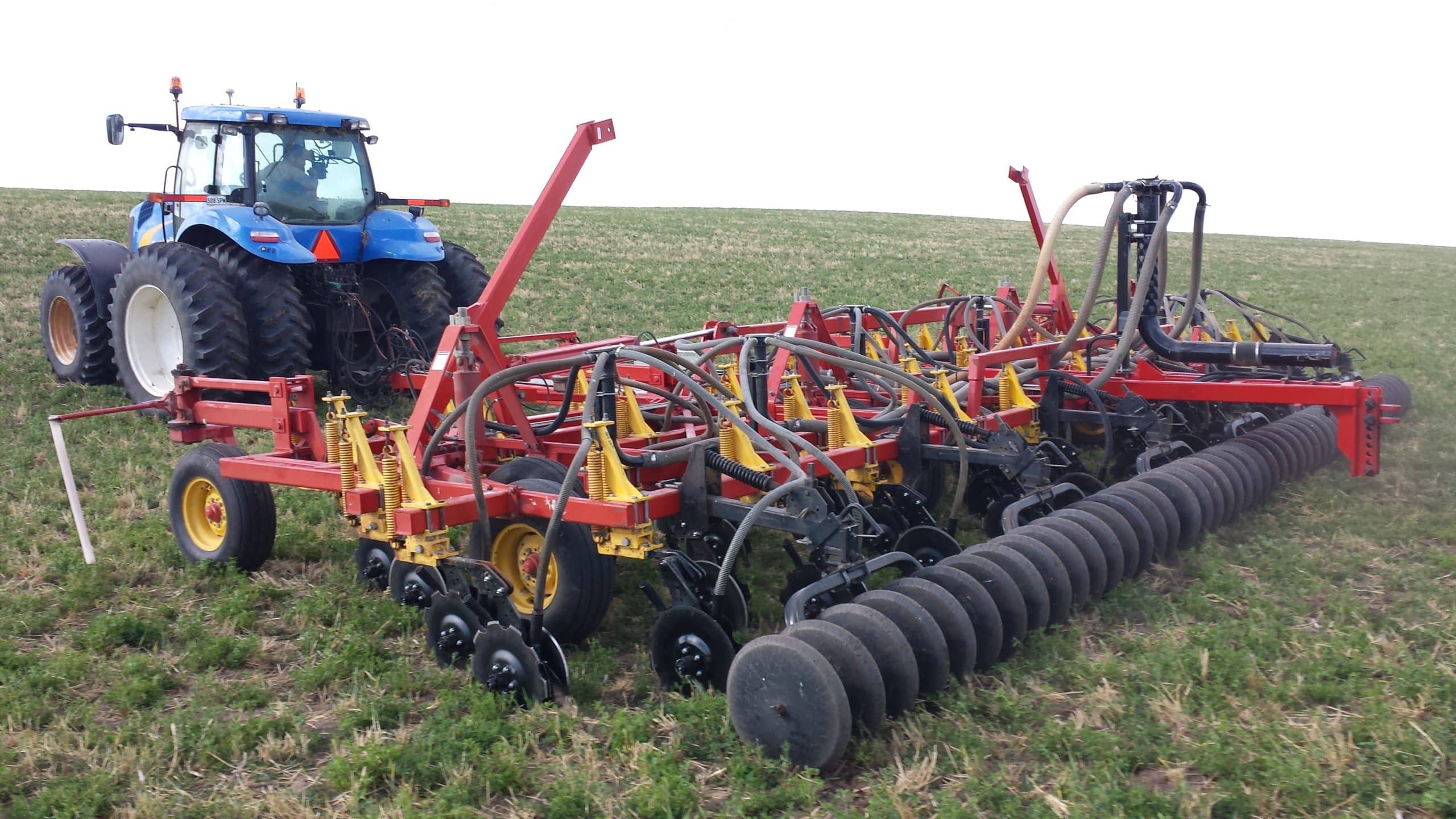
RYAN NT Double Discs fitted to Bougault 8810 Tine Seeder
The overall function of the seeding operation can be summarised as ‘to uniformly place seeds and fertiliser in the ground. Further manipulating the physical condition of the soil near the seed zone and surface residue.
Ultimately, securing the maximum crop emergence and early vigour in a wide range of soil types and moisture conditions.
Seeding systems using a disc rather than a tine as the soil opener, have a direct impact an improving seedbed moisture conservation reducing weed, seed stimulation and improving crop water use efficiency.
This is due to their ability to maximise crop residue retention and minimise soil disturbance.
It is important to state that both no-till and zero-till farming are specific versions of a conservation farming approach in which:
A zero-till disc seeding system is a one-pass direct seeding operation using disc openers that achieve minimal soil and residue disturbance. This compares to no-till seeding, a similar direct seeding operation using narrow point openers that create more significant furrow loosening and soil disturbance.
No-till and Zero-till farming are versions of a conservation farming
It is important to state that both no-till and zero-till farming are specific versions of a conservation farming approach in which:
- crop residues are retained on the soil surface;
- there is no prior cultivation and soil disturbance while direct seeding is minimised;
- diverse crop rotations are implemented; and
- at best, soil compaction management, such as controlled traffic farming, is used.
However, experience suggests the adoption of zero till is sometimes best after a transition period using no-till first to improve particularly degraded soil environments.
RYAN NT retrofit discs have been designed to help transition to zero-till. The system allows farmers to convert their tine machine instead of buying a whole new zero-till seeder.
The Zero-till Disc Seeding System transition period
Vertical tillage within furrows can assist with faster root system development at depth during a no-till transition period. Figure 1 represents the evolving chain of steps leading to a zero-till conservation farming philosophy in the Australian context.
This need for the transition is due to a rolling disc blade engaging with the soil in a completely different manner to a tine. A disc blade is fundamentally a poor soil-loosening tool requiring high downward (vertical forces) for penetration in adverse soil conditions.
A blade's residue-cutting ability is also quickly and dramatically reduced by blade wear and tough residue/soft soil operating conditions.
The performance of disc seeding systems improves in farming systems that promote a reduction in soil strength and a faster rate of residue breakdown over time. This can be achieved through:
- active management of compaction risks — such as controlled traffic farming — leading to improvements in soil structure;
- increased organic matter under permanent surface residue cover and improved crop rotations; and
- improved moisture infiltration and retention through reduced disturbance.
Access many benefits after transitioning to a disc seeding system
When these issues have been addressed, disc seeding systems can lead to a more efficient zero-till farming system with benefits such as:
- higher operating speeds increasing the seeding capacity within the optimum sowing window and reducing labour costs;
- minimal soil disturbance, which reduces seedbed moisture loss and weed germination and increases the reliability of crop establishment in marginal conditions;
- the use of narrow row spacing to sow pasture and to maximise crop competition;
- more diverse crops can be established reliably in heavy residues, including cover crops;
- minimal crop residue management,
- improved performance in stony soil, without post-sowing operations; and
- minimised draft and power requirements in optimum soil conditions.
Figure 1: A representation of the evolving chain of steps leading to a zero-till conservation farming philosophy in the Australian content
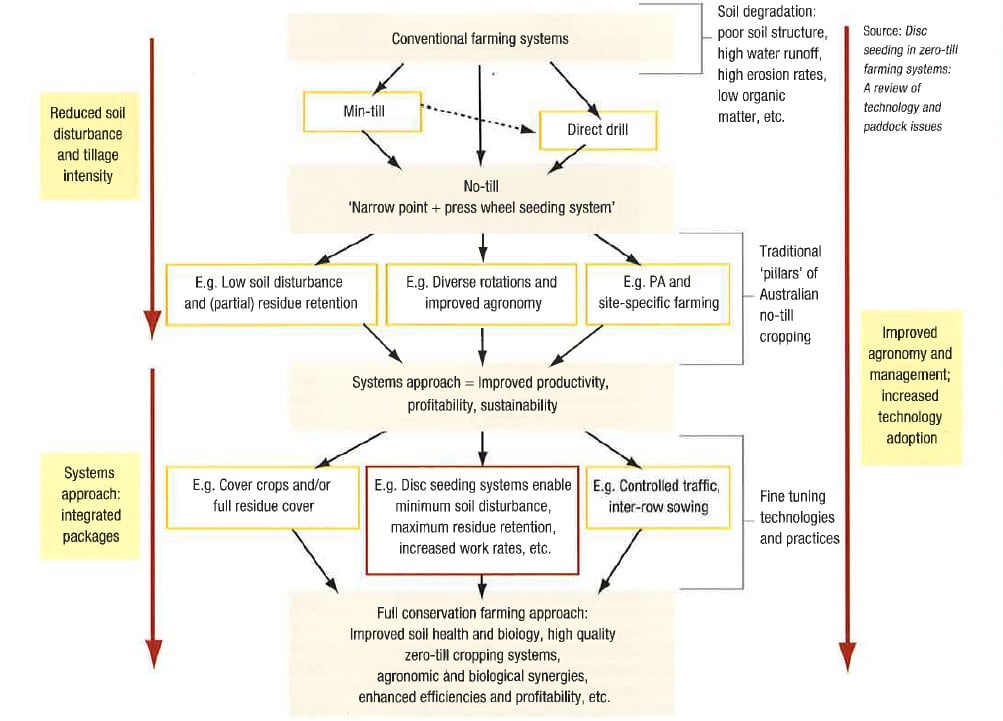
Note: The early motivations in tackling soil degradation with resiude retention and a reduction in tillage intensity have gradually shifted to developing an integrated cropping system approach. This involves various degrees of improved agronomy, managment, and technology adoption. The disc seeding system may be seen as an integral part of a fine-tuning phase enabling the multi-facets of high quality conservation agriculture to be more thoroughly and rapidly realised.
Figure 2: Examples of commercial disc coulter blade styles commonly used in Australia
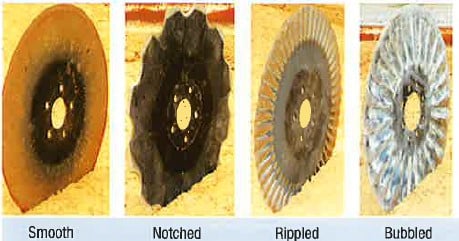
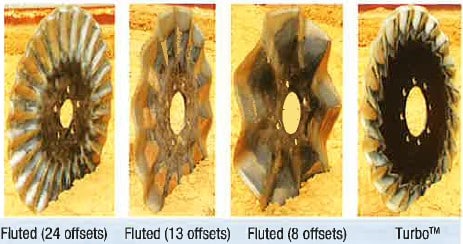
Smooth — Generally has a continuous double-devel cutting edge thinner than those used on single-seeding discs.
Notched — A flat blade with spaced, sharpened notches on the circumference. They are considered more suitable than smooth coulters in hard soils and heavy residues. Optimum notch size relates to disc diameter and intended working depth. Developed in Brazil, the ‘toothed’ blade (not shown here) is an evolution of the notched blade and requires less downward force to penetrate soil and cut residues.
Rippled and fluted — The rippled or wavy (sinusoidal) disc cutting edge increases furrow disturbance, disc drive and soil throw. Fluted blades are a coarser version of the ripple design and produce greater soil throw.
Bubbled — By positioning the convolutions away from the blade's edge, a straight cutting edge is maintained. Bubbled and dimpled blades have a more positive disc drive in softer soil conditions while maintaining low levels of furrow disturbance and soil throw.
Wavy — Reaching outward from the disc face, the larger offsets create a more pronounced sinusoidal cutting edge and more involved furrow loosening. Fewer waves (offsets) are associated with greater but irregular furrow loosening and less soil throw. They have reduced penetration and cutting capabilities compared to fluted and rippled discs.
Turbo — This style of fluted coulter blade is directional. It can generate improved cutting and more soil throw, which is achieved by the waves vertically entering the soil and leaving it horizontally. An alternative design is the Directa blade (not shown here).
A zero-till disc seeding system needs to fulfil five main functions
The seeding system in a zero-till context fulfils five main functions: residue handling, furrow loosening, seed banding, fertiliser banding, and furrow closing.
Many components have been developed and added to the disc modules to ensure all functions are best achieved. These include residue managers, independent seed pressing and furrow closing systems, double shoot technologies to separate seed and fertiliser and on-the-go adjustment of the downward pressure on the opener to counter soil strength variability.
When selecting a disc seeding system, the objective is to create a furrow that excludes crop residue (minimal hair-pinning), achieves optimum seed-to-soil contact and uniform seed depth.
The technology used to achieve this best will depend on paddock conditions and the context of the farming system.
Disc Seeding System Options
Zero-till disc openers can generally be classified into four design categories. The level of soil disturbance and soil throw created by each category is a function of blade design and the depth, speed and angle of operation.
Smooth discs, shallow depth, low speed and softer and drier soil conditions generally contribute to lowering the level of soil disturbance and soil throw.
Disc Coulters
Disc coulters are designed to cut through surface weeds and residue, loosen narrow furrows and band fertiliser. They can be mounted on a fixed or swivel assembly, often set in association with tine openers or double seeding discs. The disc blades can be flat or fluted with either a continuous or scalloped cutting edge (Figure 2).
Commonly used disc coulter blades in zero-till systems range in diameter from 430 millimetres to 510mm and thickness between 4mm to 6mm. Thinner and smaller disc blades penetrate harder soils more easily.
In sandy soils, residue-cutting coulters can be associated in opposing pairs set at a slight toe-in angle. This improves disc drive but generates more soil throw, especially in wet compacted soil conditions.
The toe-in angle also helps to control soil bridging between paired discs at narrower row spacing. Such paired arrangements are typically best for non-sticky soil conditions.
Pairs should be staggered to each other to equally control bridging between outer disc blades of adjacent pairs.
Double of triple discs
Double disc modules with appropriate depth control are considered the most accurate for seed placement of all the disc configurations. Double discs can be arranged as pairs of matching discs or staggered configurations with combinations of large and small discs or smooth and notched disc blades.
Paired discs have a sweep and tilt angle, with the discs coming together at the ‘pinch point’. Each disc has a single bevel on the outer edge. Excess or lack of contact pressure between the discs can cause early bearing failure.
Staggered arrangements with smaller trailing discs place the pinch point in the shadow of the leading disc, potentially reducing the risk of soil build-up between the discs. Different disc diameters result in differential speed at the cutting edge, which is considered to improve residue-cutting ability. This effect may be modified by the driving action of depth gauging rings fitted on either disc.
In firm and compacted soil, double discs require a large vertical force to achieve adequate penetration, which leads to furrow smearing and compaction. They are best operated behind a leading coulter in a ‘triple-disc’ combination to minimise the downward force requirement. The depth of seeding penetration is generally regulated by a rear gauge wheel, which typically acts as a furrow press wheel.
In precision disc planters, the gauge wheels are fitted on the side of the disc blades, allowing for more effective independent furrow closing tools.
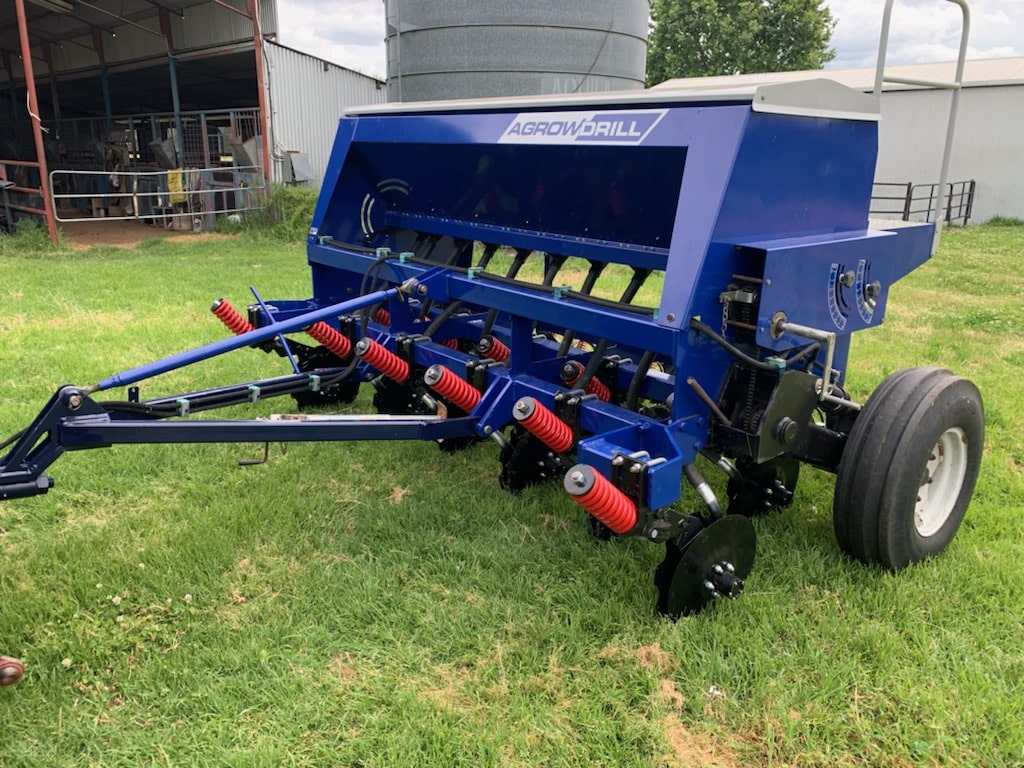
RYAN NT Double Discs fitted to an AgrowDrill
Single Discs
These modules comprise a single smooth disc with a continuous edge and a single bevel. The blade is in one of two configurations, either set vertically with a sweep angle (five to seven degrees to the direction of travel) or set at both a tilt angle (up to 20 degrees from the vertical) and sweep angle (between three and eight degrees to the direction of travel). This latter configuration gives improved penetration, but this is potentially at the expense of poorer residue cutting.
Single discs in either configuration can be designed to continuously follow ground contours or remain fixed relative to the implement frame. When fixed to the frame they will only occasionally rotate back when encountering obstacles. The latter is less accurate for seed placement across variable terrain due to a lack of depth control.
The single disc set-up experiences significant side forces that require careful balancing to minimise implement drift.
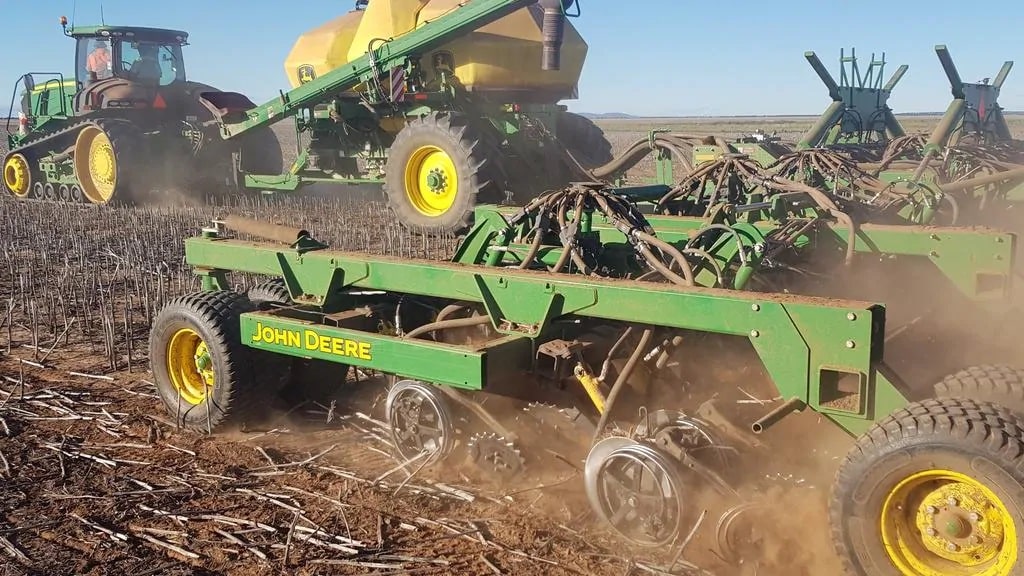
John Deere 1890 Single Disc
Hybrids
Disc/tine and disc/blade associations offer additional flexibility in fertiliser banding without compromising seed placement when associated with sub-seed soil disturbance.
Hybrids include any combination of a rolling disc blade and a fixed blade/tine opener.
Examples include:
- Disc coulters with a banding knife (for example, Yetter Mfg 2995/96 coulters);
- notched coulter with side blades (for example, Cross slot); and
- seeding tine or disc associations with fertiliser banding discs (for example, Bourgault Mid-Row Bander).
Coulters with fertiliser banding knives used in triple disc systems enable reliable and independent seed and fertiliser separation. Still, research shows they create significantly increased soil throw relative to the disc blade alone (three to four-fold), especially at higher speeds.
Things to consider
Sticky soils
The issue of sticky soils is greater as clay content increases and tends to worsen in winter rather than summer cropping. Usually, where seeding occurs in a wetting rather than drying soil profile.
Many growers reported that waiting until the surface soil forms a dry crust substantially reduced problems of discs becoming clogged with soil.
Following rainfall events, disc seeders typically sit idle for one day longer than tine-based seeders. In worst-case scenarios, extended delays of three to four days were reported in the survey by growers who were waiting for a drier surface crust (1 to 2cm). Delays can also occur daily in some situations due to heavy dew.
Any delays are also mitigated by subsequent higher work rates enabled by disc seeders and their ability to carry on seeding for longer and more reliably establish crops into marginal moisture.
RYAN NT has mitigated sticky soil issues by implementing mud-scrapers onto the inside and outside of their disc system. In addition to the the mud-scrapers we have designed the seeding boot to be at the front, which also stops blockages.
Further, if conditions are adverse, the Ryan disc seeding system allows farmers to simply switch to tines, usually only requiring two bolts to complete the job.
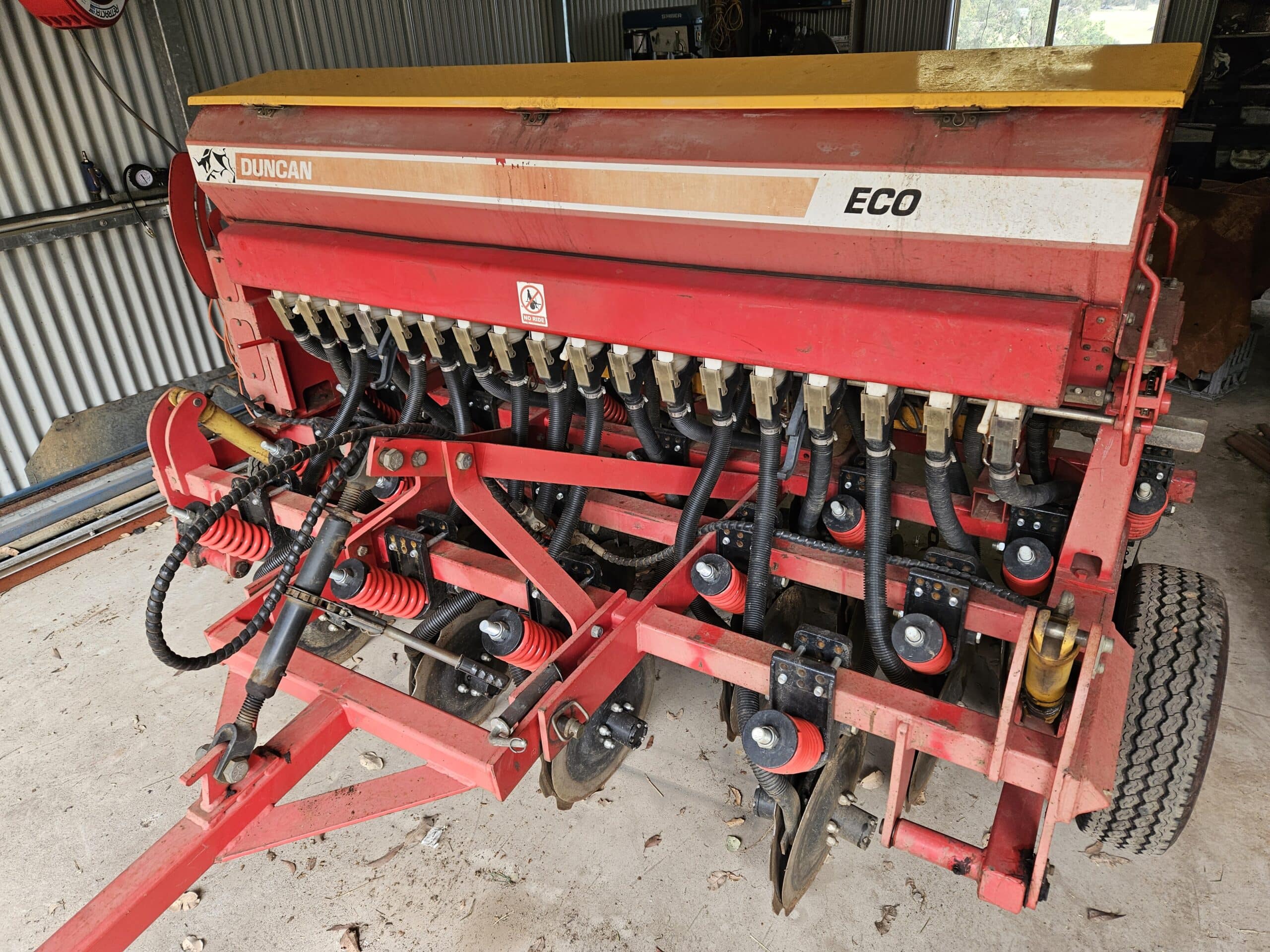
RYAN NT Double Discs fitted to a Duncan Eco Drill
Weed Control
Introducing a disc seeding machine may require a different approach to weed control than when using a tine.
This is partly because disc seeding systems aim to have less soil disturbance than tine openers, making incorporating herbicides more difficult.
Due to the need for incorporation and the risk of crop damage, many pre-emergent herbicides commonly used with tined seeding equipment are not registered for use with disc seeding systems.
Growers must consult product labels before selecting herbicides to use with disc openers and seek advice on the latest chemicals and their suitability for disc seeders.
Consequently, pre-sowing knockdown and in-crop selective herbicides, competition from crops in narrower rows and stubble cover, minimising weed germination and seed-set, and weed seed management at harvest are all essential approaches in an integrated weed management strategy when using discs.
RYAN NT has models to suit RFM, AFM, Allan Johns, Ausplow DBS, Boss, Bourgault, Conservapac, Duncan, Ezee On, Equalizer, Flexicoil, Horwood Bagshaw, Gason, Gyral, Janke, John Shearer, John Deere, Morris, Simplicity and Smale.
Click link to read fact sheet: Disc Seeding Systems Fact Sheet

